PROJ6006 Assessment 02: Case Study Analysis of Acorn Industries
VerifiedAdded on 2022/09/18
|9
|2432
|81
Case Study
AI Summary
This case study analyzes the Acorn Industries' organizational changes and leadership styles during its transition period. It critically examines the leadership styles of managers, contrasting transactional and transformational approaches. The paper explores the use of power in a contemporary leadership context, identifying five types of power and recommending referent power. It highlights the importance of employee involvement, communication, and social media in project management. The study suggests implementing Lean-Agile methodologies and semiautonomous groups to improve project efficiency, addressing challenges through flexible schedules and clear expectations. The analysis emphasizes diversity and inclusion in project teams for optimal performance, offering recommendations to alleviate challenges and improve project outcomes. The case study references various academic sources to support its analysis and recommendations.
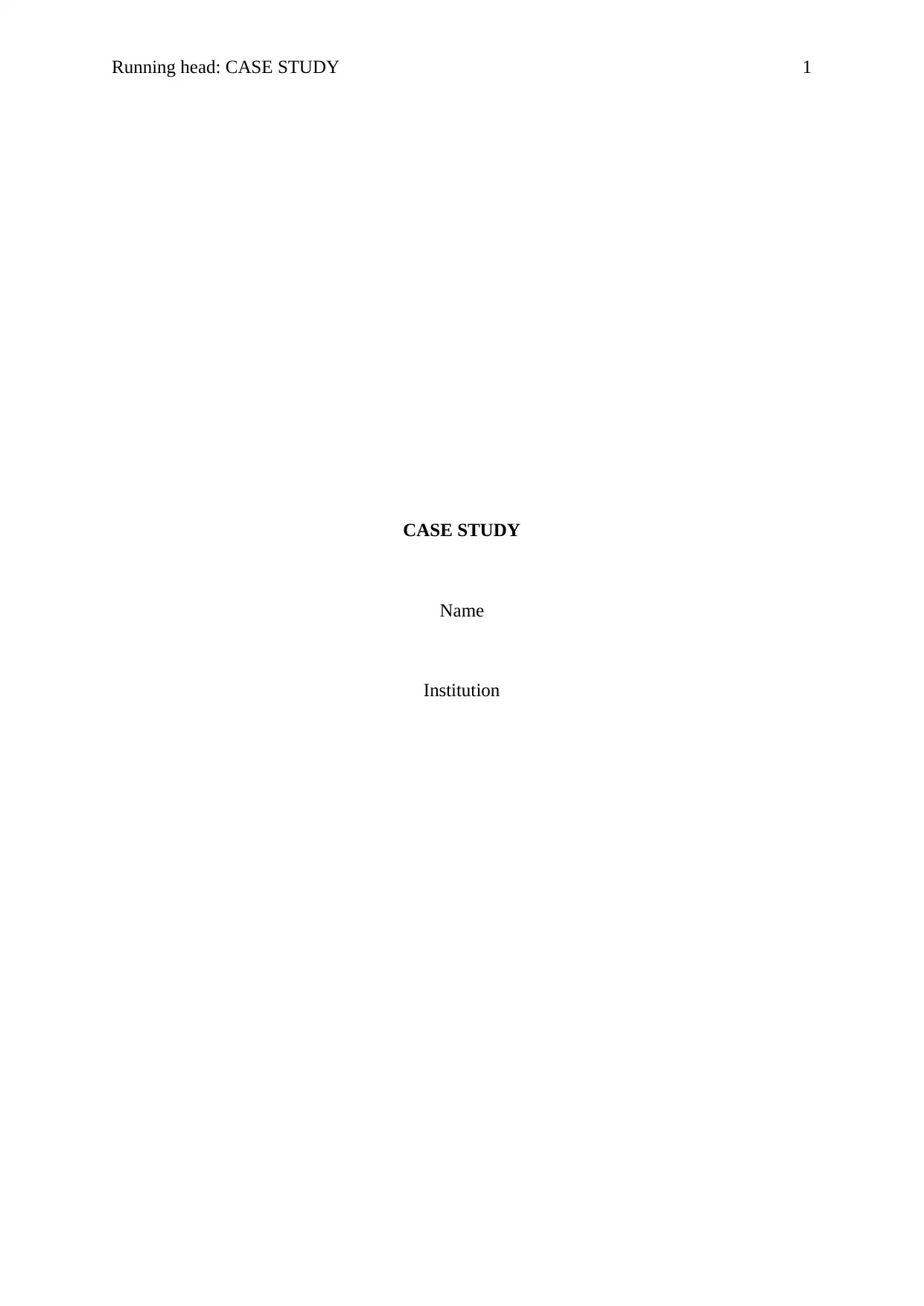
Running head: CASE STUDY 1
CASE STUDY
Name
Institution
CASE STUDY
Name
Institution
Paraphrase This Document
Need a fresh take? Get an instant paraphrase of this document with our AI Paraphraser
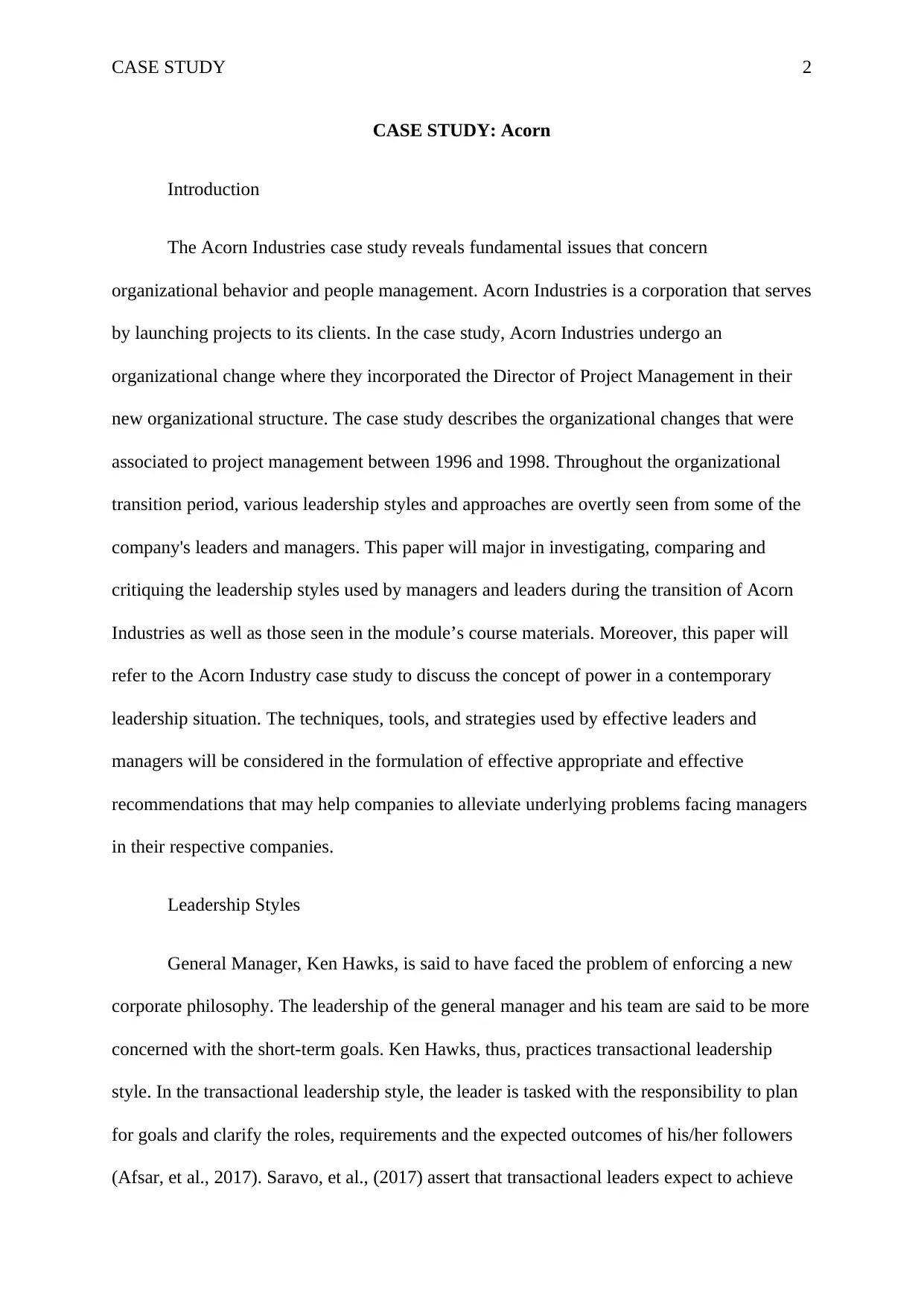
CASE STUDY 2
CASE STUDY: Acorn
Introduction
The Acorn Industries case study reveals fundamental issues that concern
organizational behavior and people management. Acorn Industries is a corporation that serves
by launching projects to its clients. In the case study, Acorn Industries undergo an
organizational change where they incorporated the Director of Project Management in their
new organizational structure. The case study describes the organizational changes that were
associated to project management between 1996 and 1998. Throughout the organizational
transition period, various leadership styles and approaches are overtly seen from some of the
company's leaders and managers. This paper will major in investigating, comparing and
critiquing the leadership styles used by managers and leaders during the transition of Acorn
Industries as well as those seen in the module’s course materials. Moreover, this paper will
refer to the Acorn Industry case study to discuss the concept of power in a contemporary
leadership situation. The techniques, tools, and strategies used by effective leaders and
managers will be considered in the formulation of effective appropriate and effective
recommendations that may help companies to alleviate underlying problems facing managers
in their respective companies.
Leadership Styles
General Manager, Ken Hawks, is said to have faced the problem of enforcing a new
corporate philosophy. The leadership of the general manager and his team are said to be more
concerned with the short-term goals. Ken Hawks, thus, practices transactional leadership
style. In the transactional leadership style, the leader is tasked with the responsibility to plan
for goals and clarify the roles, requirements and the expected outcomes of his/her followers
(Afsar, et al., 2017). Saravo, et al., (2017) assert that transactional leaders expect to achieve
CASE STUDY: Acorn
Introduction
The Acorn Industries case study reveals fundamental issues that concern
organizational behavior and people management. Acorn Industries is a corporation that serves
by launching projects to its clients. In the case study, Acorn Industries undergo an
organizational change where they incorporated the Director of Project Management in their
new organizational structure. The case study describes the organizational changes that were
associated to project management between 1996 and 1998. Throughout the organizational
transition period, various leadership styles and approaches are overtly seen from some of the
company's leaders and managers. This paper will major in investigating, comparing and
critiquing the leadership styles used by managers and leaders during the transition of Acorn
Industries as well as those seen in the module’s course materials. Moreover, this paper will
refer to the Acorn Industry case study to discuss the concept of power in a contemporary
leadership situation. The techniques, tools, and strategies used by effective leaders and
managers will be considered in the formulation of effective appropriate and effective
recommendations that may help companies to alleviate underlying problems facing managers
in their respective companies.
Leadership Styles
General Manager, Ken Hawks, is said to have faced the problem of enforcing a new
corporate philosophy. The leadership of the general manager and his team are said to be more
concerned with the short-term goals. Ken Hawks, thus, practices transactional leadership
style. In the transactional leadership style, the leader is tasked with the responsibility to plan
for goals and clarify the roles, requirements and the expected outcomes of his/her followers
(Afsar, et al., 2017). Saravo, et al., (2017) assert that transactional leaders expect to achieve
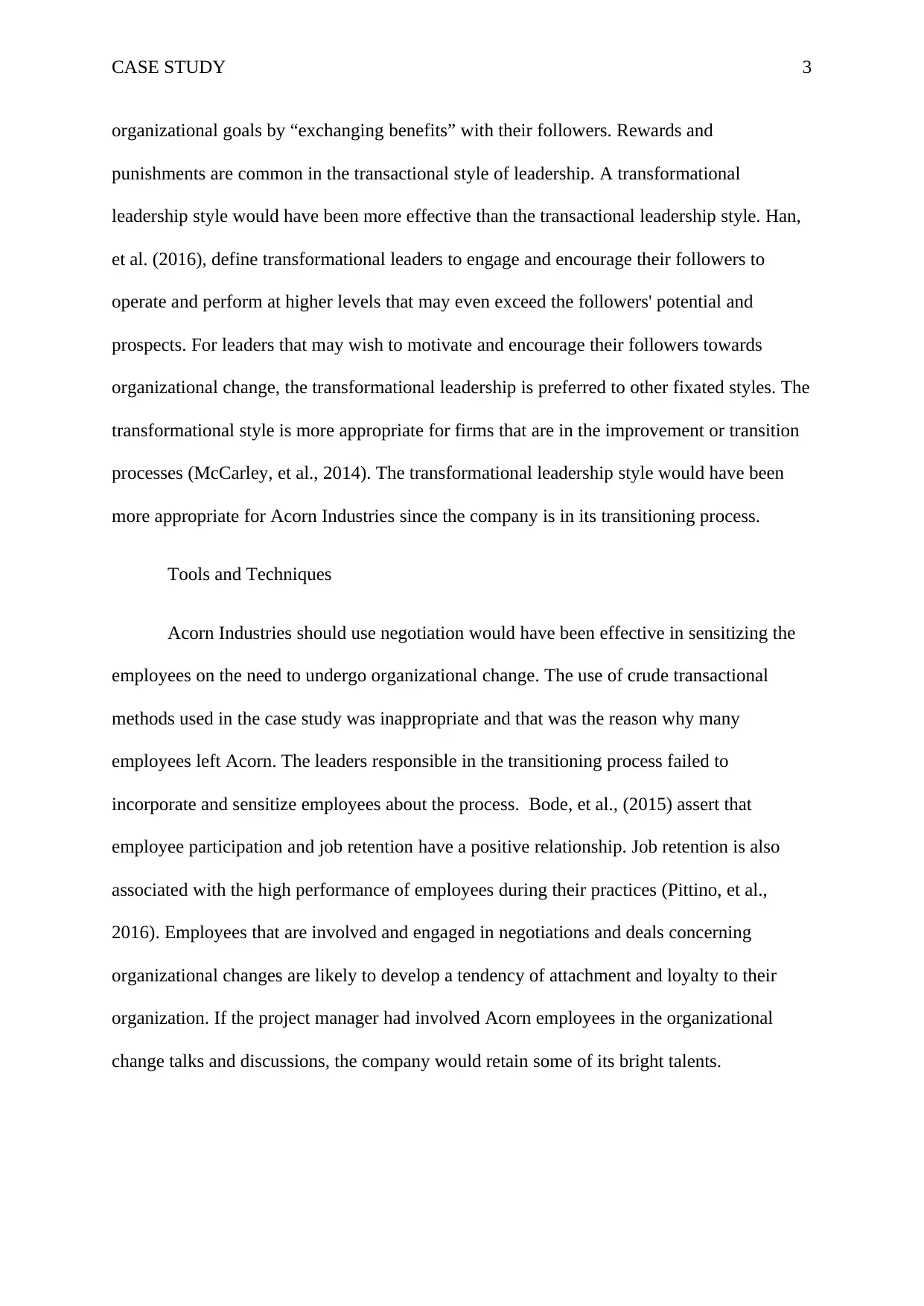
CASE STUDY 3
organizational goals by “exchanging benefits” with their followers. Rewards and
punishments are common in the transactional style of leadership. A transformational
leadership style would have been more effective than the transactional leadership style. Han,
et al. (2016), define transformational leaders to engage and encourage their followers to
operate and perform at higher levels that may even exceed the followers' potential and
prospects. For leaders that may wish to motivate and encourage their followers towards
organizational change, the transformational leadership is preferred to other fixated styles. The
transformational style is more appropriate for firms that are in the improvement or transition
processes (McCarley, et al., 2014). The transformational leadership style would have been
more appropriate for Acorn Industries since the company is in its transitioning process.
Tools and Techniques
Acorn Industries should use negotiation would have been effective in sensitizing the
employees on the need to undergo organizational change. The use of crude transactional
methods used in the case study was inappropriate and that was the reason why many
employees left Acorn. The leaders responsible in the transitioning process failed to
incorporate and sensitize employees about the process. Bode, et al., (2015) assert that
employee participation and job retention have a positive relationship. Job retention is also
associated with the high performance of employees during their practices (Pittino, et al.,
2016). Employees that are involved and engaged in negotiations and deals concerning
organizational changes are likely to develop a tendency of attachment and loyalty to their
organization. If the project manager had involved Acorn employees in the organizational
change talks and discussions, the company would retain some of its bright talents.
organizational goals by “exchanging benefits” with their followers. Rewards and
punishments are common in the transactional style of leadership. A transformational
leadership style would have been more effective than the transactional leadership style. Han,
et al. (2016), define transformational leaders to engage and encourage their followers to
operate and perform at higher levels that may even exceed the followers' potential and
prospects. For leaders that may wish to motivate and encourage their followers towards
organizational change, the transformational leadership is preferred to other fixated styles. The
transformational style is more appropriate for firms that are in the improvement or transition
processes (McCarley, et al., 2014). The transformational leadership style would have been
more appropriate for Acorn Industries since the company is in its transitioning process.
Tools and Techniques
Acorn Industries should use negotiation would have been effective in sensitizing the
employees on the need to undergo organizational change. The use of crude transactional
methods used in the case study was inappropriate and that was the reason why many
employees left Acorn. The leaders responsible in the transitioning process failed to
incorporate and sensitize employees about the process. Bode, et al., (2015) assert that
employee participation and job retention have a positive relationship. Job retention is also
associated with the high performance of employees during their practices (Pittino, et al.,
2016). Employees that are involved and engaged in negotiations and deals concerning
organizational changes are likely to develop a tendency of attachment and loyalty to their
organization. If the project manager had involved Acorn employees in the organizational
change talks and discussions, the company would retain some of its bright talents.
⊘ This is a preview!⊘
Do you want full access?
Subscribe today to unlock all pages.

Trusted by 1+ million students worldwide
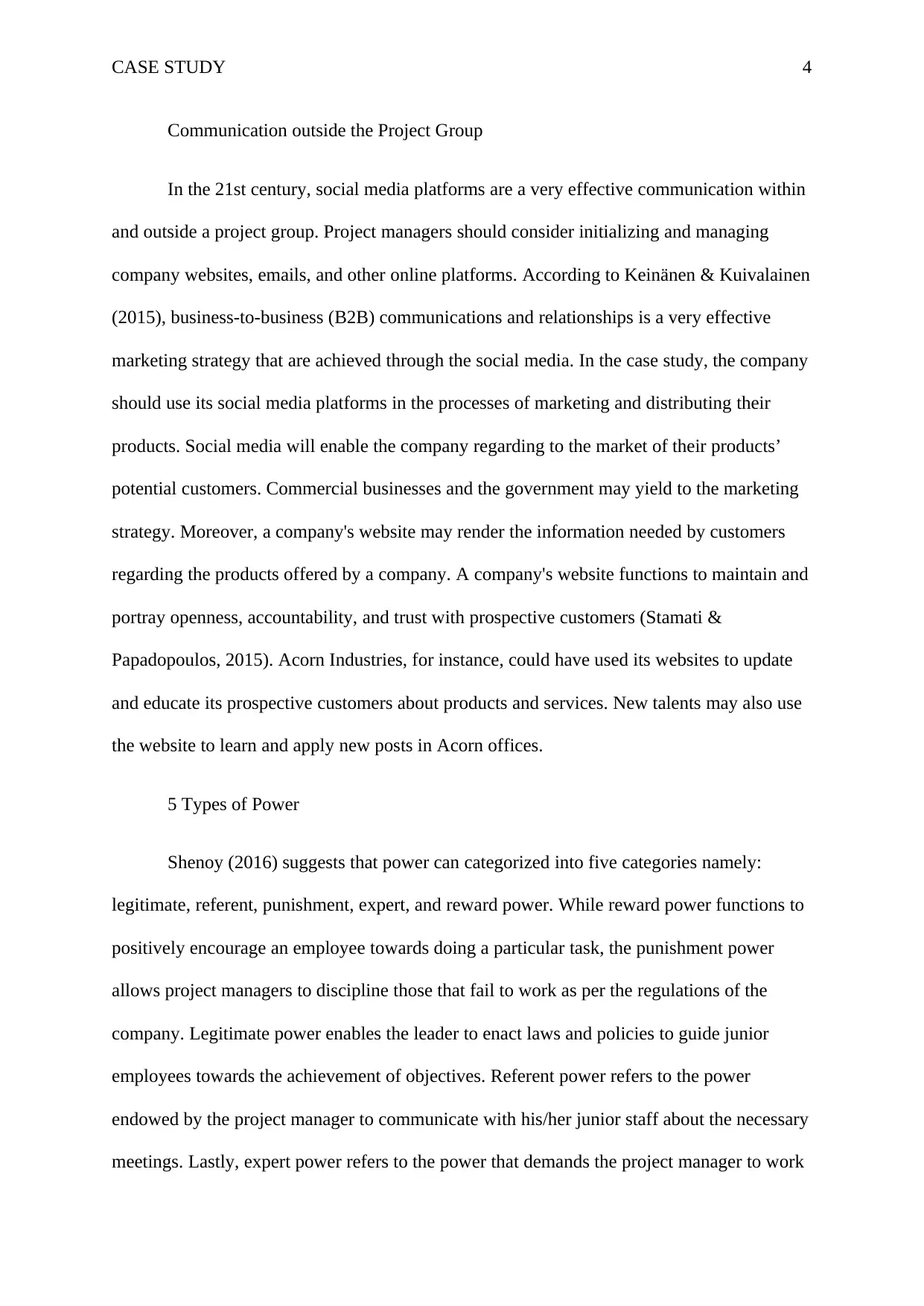
CASE STUDY 4
Communication outside the Project Group
In the 21st century, social media platforms are a very effective communication within
and outside a project group. Project managers should consider initializing and managing
company websites, emails, and other online platforms. According to Keinänen & Kuivalainen
(2015), business-to-business (B2B) communications and relationships is a very effective
marketing strategy that are achieved through the social media. In the case study, the company
should use its social media platforms in the processes of marketing and distributing their
products. Social media will enable the company regarding to the market of their products’
potential customers. Commercial businesses and the government may yield to the marketing
strategy. Moreover, a company's website may render the information needed by customers
regarding the products offered by a company. A company's website functions to maintain and
portray openness, accountability, and trust with prospective customers (Stamati &
Papadopoulos, 2015). Acorn Industries, for instance, could have used its websites to update
and educate its prospective customers about products and services. New talents may also use
the website to learn and apply new posts in Acorn offices.
5 Types of Power
Shenoy (2016) suggests that power can categorized into five categories namely:
legitimate, referent, punishment, expert, and reward power. While reward power functions to
positively encourage an employee towards doing a particular task, the punishment power
allows project managers to discipline those that fail to work as per the regulations of the
company. Legitimate power enables the leader to enact laws and policies to guide junior
employees towards the achievement of objectives. Referent power refers to the power
endowed by the project manager to communicate with his/her junior staff about the necessary
meetings. Lastly, expert power refers to the power that demands the project manager to work
Communication outside the Project Group
In the 21st century, social media platforms are a very effective communication within
and outside a project group. Project managers should consider initializing and managing
company websites, emails, and other online platforms. According to Keinänen & Kuivalainen
(2015), business-to-business (B2B) communications and relationships is a very effective
marketing strategy that are achieved through the social media. In the case study, the company
should use its social media platforms in the processes of marketing and distributing their
products. Social media will enable the company regarding to the market of their products’
potential customers. Commercial businesses and the government may yield to the marketing
strategy. Moreover, a company's website may render the information needed by customers
regarding the products offered by a company. A company's website functions to maintain and
portray openness, accountability, and trust with prospective customers (Stamati &
Papadopoulos, 2015). Acorn Industries, for instance, could have used its websites to update
and educate its prospective customers about products and services. New talents may also use
the website to learn and apply new posts in Acorn offices.
5 Types of Power
Shenoy (2016) suggests that power can categorized into five categories namely:
legitimate, referent, punishment, expert, and reward power. While reward power functions to
positively encourage an employee towards doing a particular task, the punishment power
allows project managers to discipline those that fail to work as per the regulations of the
company. Legitimate power enables the leader to enact laws and policies to guide junior
employees towards the achievement of objectives. Referent power refers to the power
endowed by the project manager to communicate with his/her junior staff about the necessary
meetings. Lastly, expert power refers to the power that demands the project manager to work
Paraphrase This Document
Need a fresh take? Get an instant paraphrase of this document with our AI Paraphraser
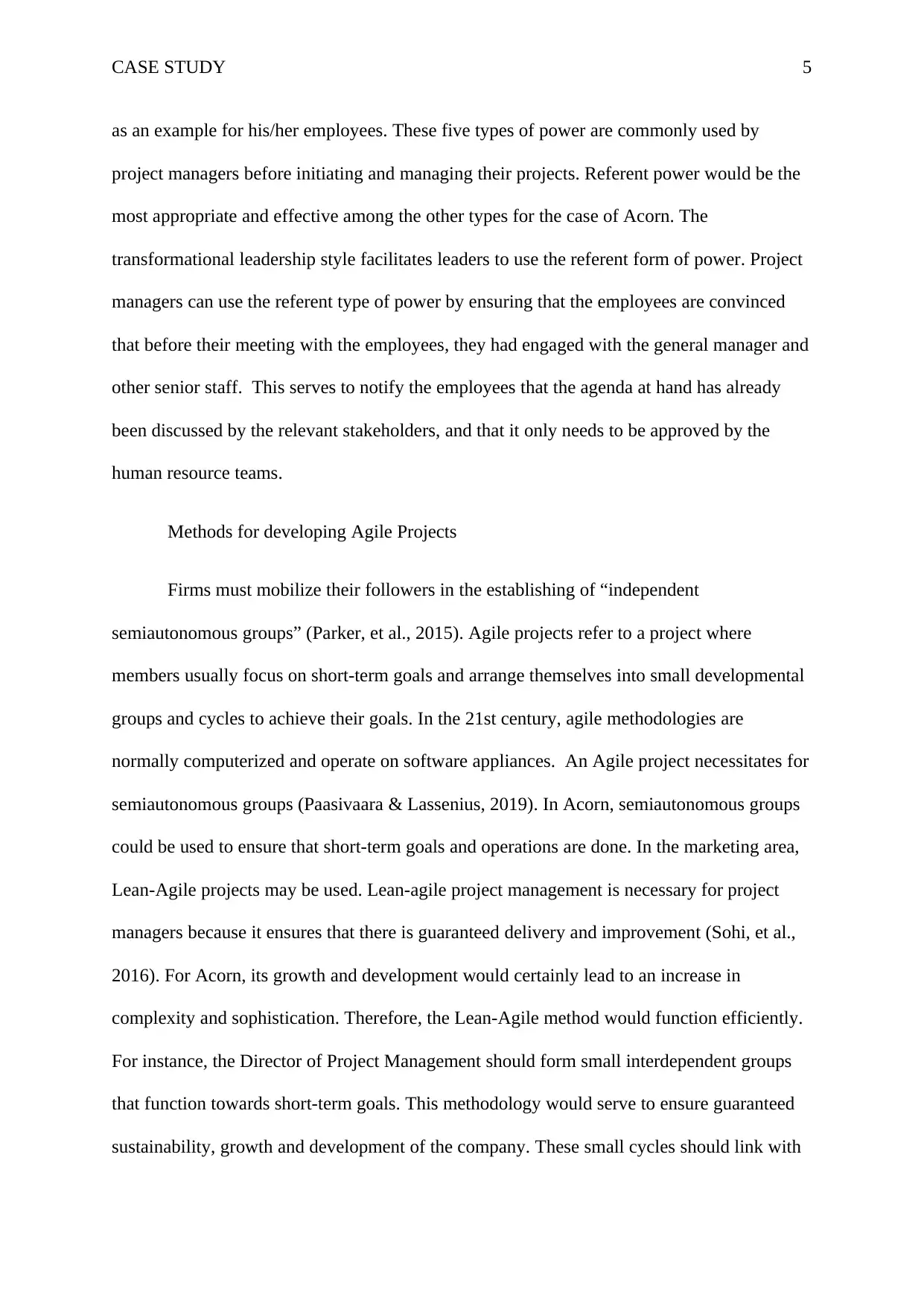
CASE STUDY 5
as an example for his/her employees. These five types of power are commonly used by
project managers before initiating and managing their projects. Referent power would be the
most appropriate and effective among the other types for the case of Acorn. The
transformational leadership style facilitates leaders to use the referent form of power. Project
managers can use the referent type of power by ensuring that the employees are convinced
that before their meeting with the employees, they had engaged with the general manager and
other senior staff. This serves to notify the employees that the agenda at hand has already
been discussed by the relevant stakeholders, and that it only needs to be approved by the
human resource teams.
Methods for developing Agile Projects
Firms must mobilize their followers in the establishing of “independent
semiautonomous groups” (Parker, et al., 2015). Agile projects refer to a project where
members usually focus on short-term goals and arrange themselves into small developmental
groups and cycles to achieve their goals. In the 21st century, agile methodologies are
normally computerized and operate on software appliances. An Agile project necessitates for
semiautonomous groups (Paasivaara & Lassenius, 2019). In Acorn, semiautonomous groups
could be used to ensure that short-term goals and operations are done. In the marketing area,
Lean-Agile projects may be used. Lean-agile project management is necessary for project
managers because it ensures that there is guaranteed delivery and improvement (Sohi, et al.,
2016). For Acorn, its growth and development would certainly lead to an increase in
complexity and sophistication. Therefore, the Lean-Agile method would function efficiently.
For instance, the Director of Project Management should form small interdependent groups
that function towards short-term goals. This methodology would serve to ensure guaranteed
sustainability, growth and development of the company. These small cycles should link with
as an example for his/her employees. These five types of power are commonly used by
project managers before initiating and managing their projects. Referent power would be the
most appropriate and effective among the other types for the case of Acorn. The
transformational leadership style facilitates leaders to use the referent form of power. Project
managers can use the referent type of power by ensuring that the employees are convinced
that before their meeting with the employees, they had engaged with the general manager and
other senior staff. This serves to notify the employees that the agenda at hand has already
been discussed by the relevant stakeholders, and that it only needs to be approved by the
human resource teams.
Methods for developing Agile Projects
Firms must mobilize their followers in the establishing of “independent
semiautonomous groups” (Parker, et al., 2015). Agile projects refer to a project where
members usually focus on short-term goals and arrange themselves into small developmental
groups and cycles to achieve their goals. In the 21st century, agile methodologies are
normally computerized and operate on software appliances. An Agile project necessitates for
semiautonomous groups (Paasivaara & Lassenius, 2019). In Acorn, semiautonomous groups
could be used to ensure that short-term goals and operations are done. In the marketing area,
Lean-Agile projects may be used. Lean-agile project management is necessary for project
managers because it ensures that there is guaranteed delivery and improvement (Sohi, et al.,
2016). For Acorn, its growth and development would certainly lead to an increase in
complexity and sophistication. Therefore, the Lean-Agile method would function efficiently.
For instance, the Director of Project Management should form small interdependent groups
that function towards short-term goals. This methodology would serve to ensure guaranteed
sustainability, growth and development of the company. These small cycles should link with
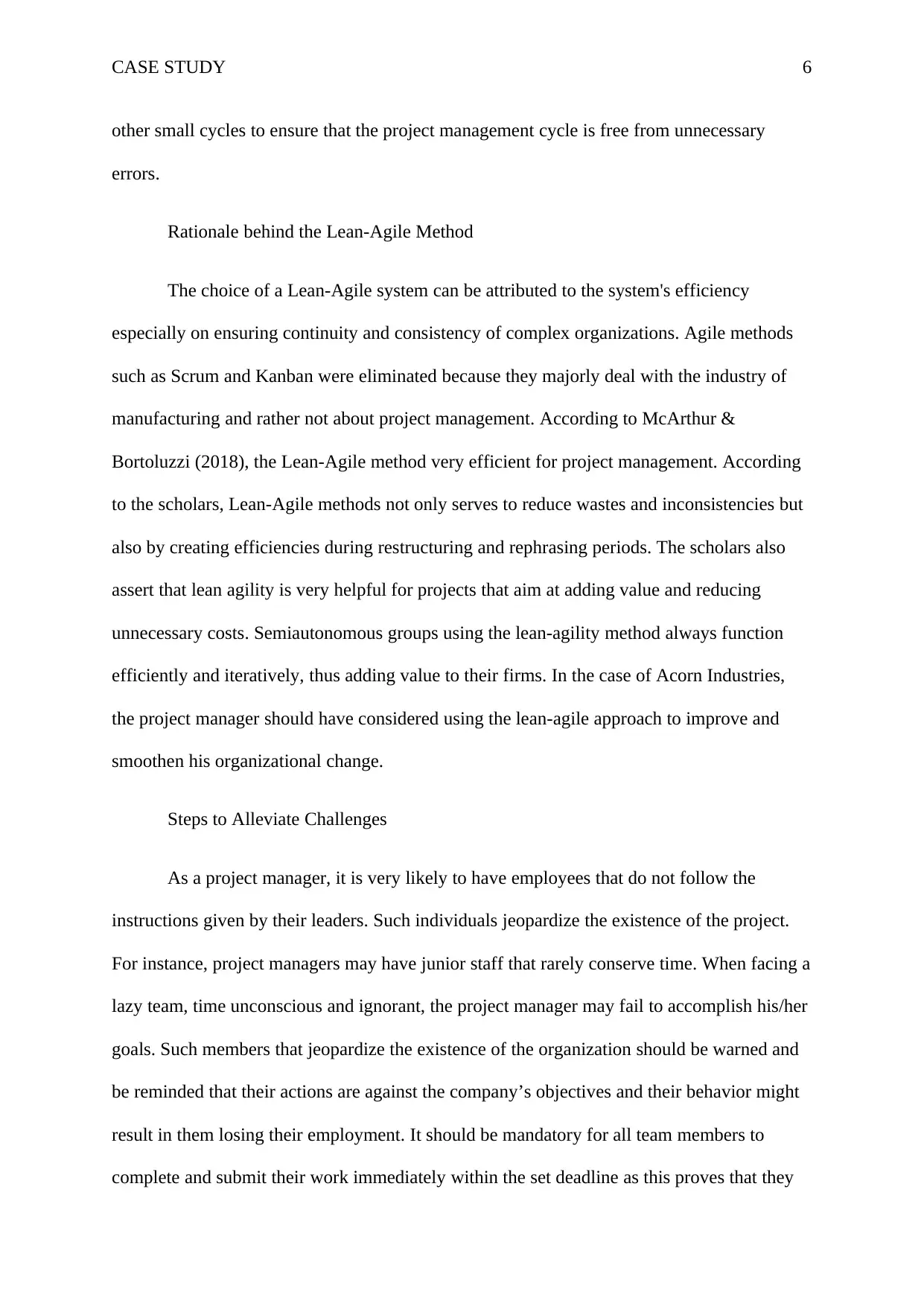
CASE STUDY 6
other small cycles to ensure that the project management cycle is free from unnecessary
errors.
Rationale behind the Lean-Agile Method
The choice of a Lean-Agile system can be attributed to the system's efficiency
especially on ensuring continuity and consistency of complex organizations. Agile methods
such as Scrum and Kanban were eliminated because they majorly deal with the industry of
manufacturing and rather not about project management. According to McArthur &
Bortoluzzi (2018), the Lean-Agile method very efficient for project management. According
to the scholars, Lean-Agile methods not only serves to reduce wastes and inconsistencies but
also by creating efficiencies during restructuring and rephrasing periods. The scholars also
assert that lean agility is very helpful for projects that aim at adding value and reducing
unnecessary costs. Semiautonomous groups using the lean-agility method always function
efficiently and iteratively, thus adding value to their firms. In the case of Acorn Industries,
the project manager should have considered using the lean-agile approach to improve and
smoothen his organizational change.
Steps to Alleviate Challenges
As a project manager, it is very likely to have employees that do not follow the
instructions given by their leaders. Such individuals jeopardize the existence of the project.
For instance, project managers may have junior staff that rarely conserve time. When facing a
lazy team, time unconscious and ignorant, the project manager may fail to accomplish his/her
goals. Such members that jeopardize the existence of the organization should be warned and
be reminded that their actions are against the company’s objectives and their behavior might
result in them losing their employment. It should be mandatory for all team members to
complete and submit their work immediately within the set deadline as this proves that they
other small cycles to ensure that the project management cycle is free from unnecessary
errors.
Rationale behind the Lean-Agile Method
The choice of a Lean-Agile system can be attributed to the system's efficiency
especially on ensuring continuity and consistency of complex organizations. Agile methods
such as Scrum and Kanban were eliminated because they majorly deal with the industry of
manufacturing and rather not about project management. According to McArthur &
Bortoluzzi (2018), the Lean-Agile method very efficient for project management. According
to the scholars, Lean-Agile methods not only serves to reduce wastes and inconsistencies but
also by creating efficiencies during restructuring and rephrasing periods. The scholars also
assert that lean agility is very helpful for projects that aim at adding value and reducing
unnecessary costs. Semiautonomous groups using the lean-agility method always function
efficiently and iteratively, thus adding value to their firms. In the case of Acorn Industries,
the project manager should have considered using the lean-agile approach to improve and
smoothen his organizational change.
Steps to Alleviate Challenges
As a project manager, it is very likely to have employees that do not follow the
instructions given by their leaders. Such individuals jeopardize the existence of the project.
For instance, project managers may have junior staff that rarely conserve time. When facing a
lazy team, time unconscious and ignorant, the project manager may fail to accomplish his/her
goals. Such members that jeopardize the existence of the organization should be warned and
be reminded that their actions are against the company’s objectives and their behavior might
result in them losing their employment. It should be mandatory for all team members to
complete and submit their work immediately within the set deadline as this proves that they
⊘ This is a preview!⊘
Do you want full access?
Subscribe today to unlock all pages.

Trusted by 1+ million students worldwide
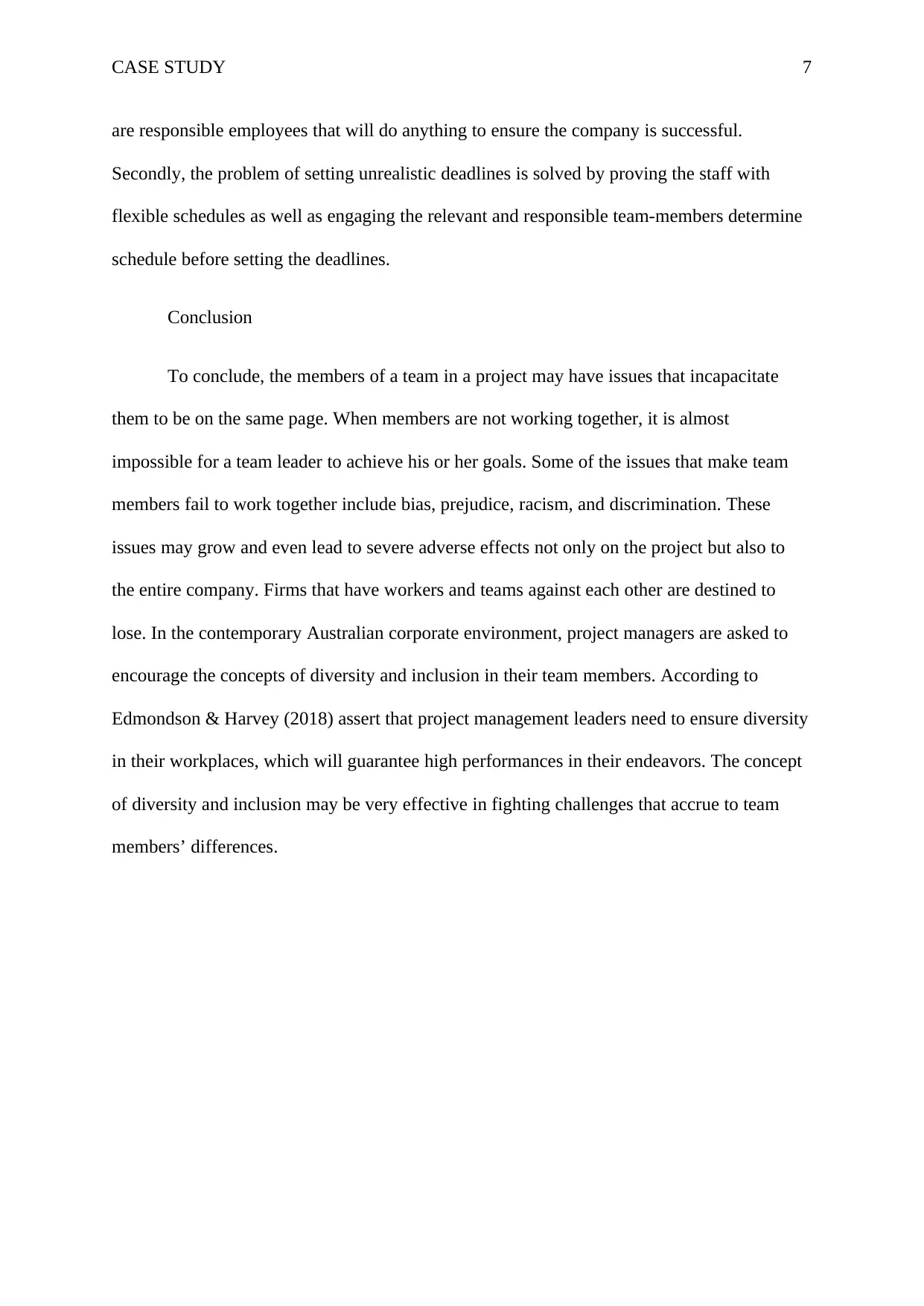
CASE STUDY 7
are responsible employees that will do anything to ensure the company is successful.
Secondly, the problem of setting unrealistic deadlines is solved by proving the staff with
flexible schedules as well as engaging the relevant and responsible team-members determine
schedule before setting the deadlines.
Conclusion
To conclude, the members of a team in a project may have issues that incapacitate
them to be on the same page. When members are not working together, it is almost
impossible for a team leader to achieve his or her goals. Some of the issues that make team
members fail to work together include bias, prejudice, racism, and discrimination. These
issues may grow and even lead to severe adverse effects not only on the project but also to
the entire company. Firms that have workers and teams against each other are destined to
lose. In the contemporary Australian corporate environment, project managers are asked to
encourage the concepts of diversity and inclusion in their team members. According to
Edmondson & Harvey (2018) assert that project management leaders need to ensure diversity
in their workplaces, which will guarantee high performances in their endeavors. The concept
of diversity and inclusion may be very effective in fighting challenges that accrue to team
members’ differences.
are responsible employees that will do anything to ensure the company is successful.
Secondly, the problem of setting unrealistic deadlines is solved by proving the staff with
flexible schedules as well as engaging the relevant and responsible team-members determine
schedule before setting the deadlines.
Conclusion
To conclude, the members of a team in a project may have issues that incapacitate
them to be on the same page. When members are not working together, it is almost
impossible for a team leader to achieve his or her goals. Some of the issues that make team
members fail to work together include bias, prejudice, racism, and discrimination. These
issues may grow and even lead to severe adverse effects not only on the project but also to
the entire company. Firms that have workers and teams against each other are destined to
lose. In the contemporary Australian corporate environment, project managers are asked to
encourage the concepts of diversity and inclusion in their team members. According to
Edmondson & Harvey (2018) assert that project management leaders need to ensure diversity
in their workplaces, which will guarantee high performances in their endeavors. The concept
of diversity and inclusion may be very effective in fighting challenges that accrue to team
members’ differences.
Paraphrase This Document
Need a fresh take? Get an instant paraphrase of this document with our AI Paraphraser
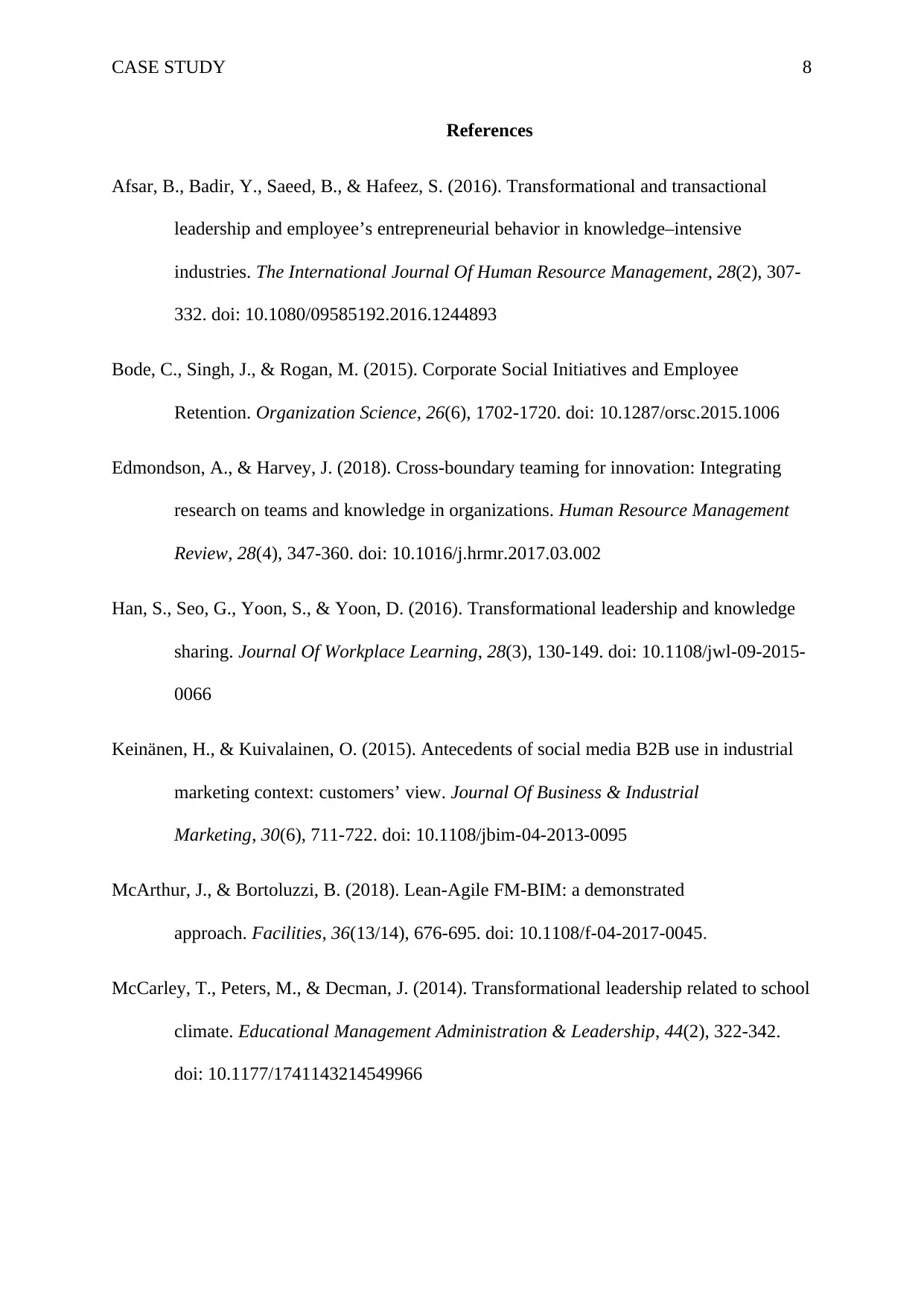
CASE STUDY 8
References
Afsar, B., Badir, Y., Saeed, B., & Hafeez, S. (2016). Transformational and transactional
leadership and employee’s entrepreneurial behavior in knowledge–intensive
industries. The International Journal Of Human Resource Management, 28(2), 307-
332. doi: 10.1080/09585192.2016.1244893
Bode, C., Singh, J., & Rogan, M. (2015). Corporate Social Initiatives and Employee
Retention. Organization Science, 26(6), 1702-1720. doi: 10.1287/orsc.2015.1006
Edmondson, A., & Harvey, J. (2018). Cross-boundary teaming for innovation: Integrating
research on teams and knowledge in organizations. Human Resource Management
Review, 28(4), 347-360. doi: 10.1016/j.hrmr.2017.03.002
Han, S., Seo, G., Yoon, S., & Yoon, D. (2016). Transformational leadership and knowledge
sharing. Journal Of Workplace Learning, 28(3), 130-149. doi: 10.1108/jwl-09-2015-
0066
Keinänen, H., & Kuivalainen, O. (2015). Antecedents of social media B2B use in industrial
marketing context: customers’ view. Journal Of Business & Industrial
Marketing, 30(6), 711-722. doi: 10.1108/jbim-04-2013-0095
McArthur, J., & Bortoluzzi, B. (2018). Lean-Agile FM-BIM: a demonstrated
approach. Facilities, 36(13/14), 676-695. doi: 10.1108/f-04-2017-0045.
McCarley, T., Peters, M., & Decman, J. (2014). Transformational leadership related to school
climate. Educational Management Administration & Leadership, 44(2), 322-342.
doi: 10.1177/1741143214549966
References
Afsar, B., Badir, Y., Saeed, B., & Hafeez, S. (2016). Transformational and transactional
leadership and employee’s entrepreneurial behavior in knowledge–intensive
industries. The International Journal Of Human Resource Management, 28(2), 307-
332. doi: 10.1080/09585192.2016.1244893
Bode, C., Singh, J., & Rogan, M. (2015). Corporate Social Initiatives and Employee
Retention. Organization Science, 26(6), 1702-1720. doi: 10.1287/orsc.2015.1006
Edmondson, A., & Harvey, J. (2018). Cross-boundary teaming for innovation: Integrating
research on teams and knowledge in organizations. Human Resource Management
Review, 28(4), 347-360. doi: 10.1016/j.hrmr.2017.03.002
Han, S., Seo, G., Yoon, S., & Yoon, D. (2016). Transformational leadership and knowledge
sharing. Journal Of Workplace Learning, 28(3), 130-149. doi: 10.1108/jwl-09-2015-
0066
Keinänen, H., & Kuivalainen, O. (2015). Antecedents of social media B2B use in industrial
marketing context: customers’ view. Journal Of Business & Industrial
Marketing, 30(6), 711-722. doi: 10.1108/jbim-04-2013-0095
McArthur, J., & Bortoluzzi, B. (2018). Lean-Agile FM-BIM: a demonstrated
approach. Facilities, 36(13/14), 676-695. doi: 10.1108/f-04-2017-0045.
McCarley, T., Peters, M., & Decman, J. (2014). Transformational leadership related to school
climate. Educational Management Administration & Leadership, 44(2), 322-342.
doi: 10.1177/1741143214549966
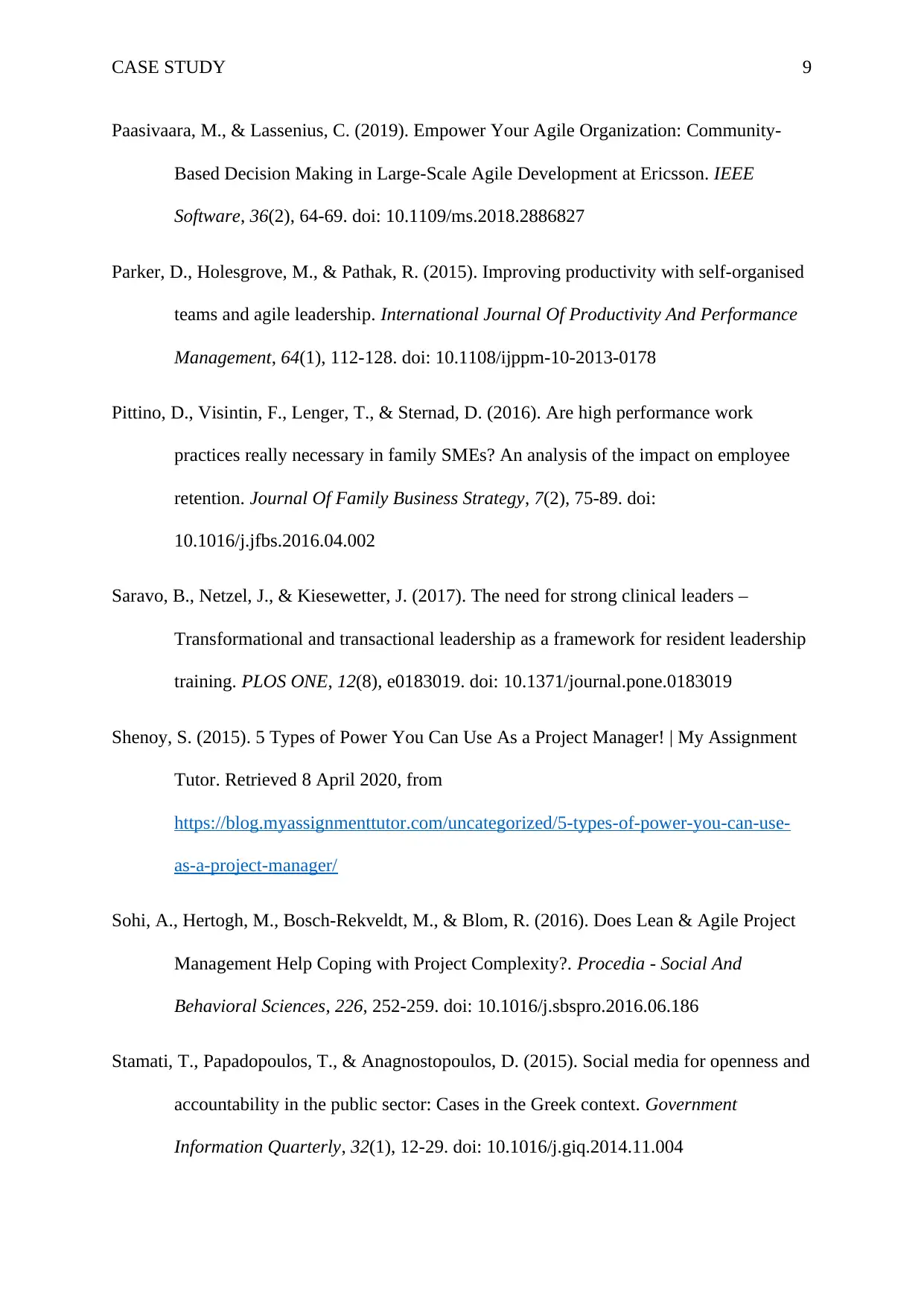
CASE STUDY 9
Paasivaara, M., & Lassenius, C. (2019). Empower Your Agile Organization: Community-
Based Decision Making in Large-Scale Agile Development at Ericsson. IEEE
Software, 36(2), 64-69. doi: 10.1109/ms.2018.2886827
Parker, D., Holesgrove, M., & Pathak, R. (2015). Improving productivity with self-organised
teams and agile leadership. International Journal Of Productivity And Performance
Management, 64(1), 112-128. doi: 10.1108/ijppm-10-2013-0178
Pittino, D., Visintin, F., Lenger, T., & Sternad, D. (2016). Are high performance work
practices really necessary in family SMEs? An analysis of the impact on employee
retention. Journal Of Family Business Strategy, 7(2), 75-89. doi:
10.1016/j.jfbs.2016.04.002
Saravo, B., Netzel, J., & Kiesewetter, J. (2017). The need for strong clinical leaders –
Transformational and transactional leadership as a framework for resident leadership
training. PLOS ONE, 12(8), e0183019. doi: 10.1371/journal.pone.0183019
Shenoy, S. (2015). 5 Types of Power You Can Use As a Project Manager! | My Assignment
Tutor. Retrieved 8 April 2020, from
https://blog.myassignmenttutor.com/uncategorized/5-types-of-power-you-can-use-
as-a-project-manager/
Sohi, A., Hertogh, M., Bosch-Rekveldt, M., & Blom, R. (2016). Does Lean & Agile Project
Management Help Coping with Project Complexity?. Procedia - Social And
Behavioral Sciences, 226, 252-259. doi: 10.1016/j.sbspro.2016.06.186
Stamati, T., Papadopoulos, T., & Anagnostopoulos, D. (2015). Social media for openness and
accountability in the public sector: Cases in the Greek context. Government
Information Quarterly, 32(1), 12-29. doi: 10.1016/j.giq.2014.11.004
Paasivaara, M., & Lassenius, C. (2019). Empower Your Agile Organization: Community-
Based Decision Making in Large-Scale Agile Development at Ericsson. IEEE
Software, 36(2), 64-69. doi: 10.1109/ms.2018.2886827
Parker, D., Holesgrove, M., & Pathak, R. (2015). Improving productivity with self-organised
teams and agile leadership. International Journal Of Productivity And Performance
Management, 64(1), 112-128. doi: 10.1108/ijppm-10-2013-0178
Pittino, D., Visintin, F., Lenger, T., & Sternad, D. (2016). Are high performance work
practices really necessary in family SMEs? An analysis of the impact on employee
retention. Journal Of Family Business Strategy, 7(2), 75-89. doi:
10.1016/j.jfbs.2016.04.002
Saravo, B., Netzel, J., & Kiesewetter, J. (2017). The need for strong clinical leaders –
Transformational and transactional leadership as a framework for resident leadership
training. PLOS ONE, 12(8), e0183019. doi: 10.1371/journal.pone.0183019
Shenoy, S. (2015). 5 Types of Power You Can Use As a Project Manager! | My Assignment
Tutor. Retrieved 8 April 2020, from
https://blog.myassignmenttutor.com/uncategorized/5-types-of-power-you-can-use-
as-a-project-manager/
Sohi, A., Hertogh, M., Bosch-Rekveldt, M., & Blom, R. (2016). Does Lean & Agile Project
Management Help Coping with Project Complexity?. Procedia - Social And
Behavioral Sciences, 226, 252-259. doi: 10.1016/j.sbspro.2016.06.186
Stamati, T., Papadopoulos, T., & Anagnostopoulos, D. (2015). Social media for openness and
accountability in the public sector: Cases in the Greek context. Government
Information Quarterly, 32(1), 12-29. doi: 10.1016/j.giq.2014.11.004
⊘ This is a preview!⊘
Do you want full access?
Subscribe today to unlock all pages.

Trusted by 1+ million students worldwide
1 out of 9
Related Documents
Your All-in-One AI-Powered Toolkit for Academic Success.
+13062052269
info@desklib.com
Available 24*7 on WhatsApp / Email
![[object Object]](/_next/static/media/star-bottom.7253800d.svg)
Unlock your academic potential
Copyright © 2020–2025 A2Z Services. All Rights Reserved. Developed and managed by ZUCOL.





